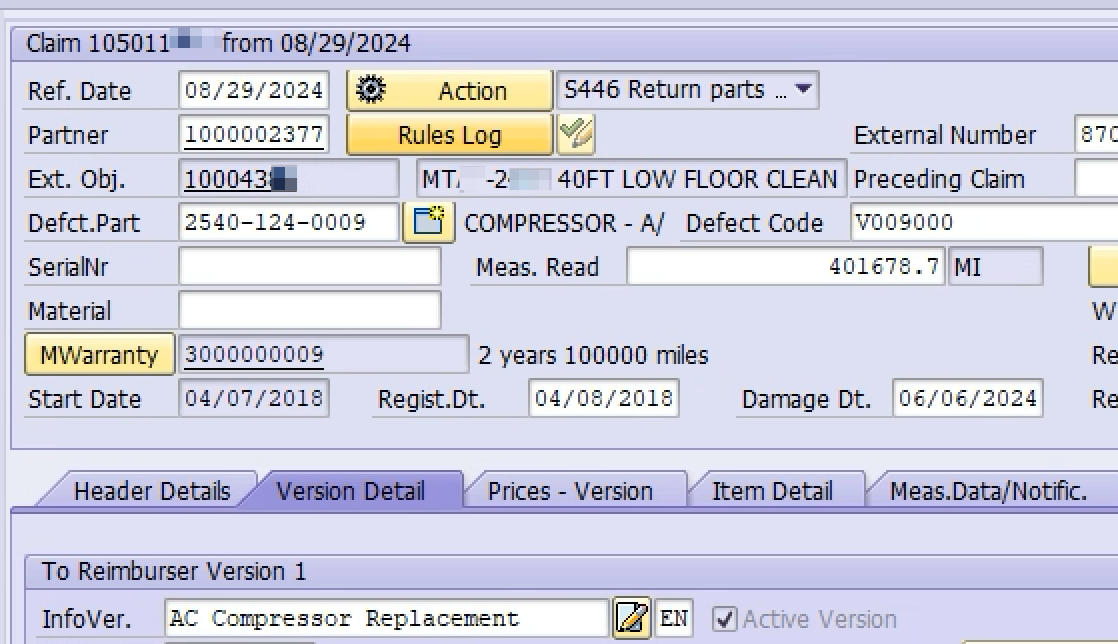Complaint, cause, and correction – the three pillars of successful warranty claim submissions and acceptance. Whether a customer is demanding a replacement smartphone or a manufacturing giant is grappling with a systemic product defect, getting this process right is paramount. This process maintains a company’s brand reputation, customer satisfaction, and bottom line. In today’s hyper-connected world, negative reviews spread like wildfire, so having a good claim complaint cause correction process is important.
The Process of Capturing and Tracking Claims Varies Across Departments
Different people in the company experience this process differently. For instance, in the Transportation Industry, where servicing buses and trains is a key aspect of operations:
An Example from the Field
At one of my clients, the process begins when an operator submits a complaint notification. This notification is then tied to a work order, which in turn generates a claim. The claim automatically inherits the 3C's (circumstances, contract, and customer).
Variations in Experience
The process can play out differently depending on the individual's role and department. While the above example illustrates one possible workflow, others may encounter distinct steps or nuances.
Image of a Claim with "Complaint" Text
We’ve all been there – a product fails to meet expectations, leaving us feeling frustrated. A recent study indicated that a single negative review can deter 22% of potential customers. Three or more negative reviews can drive away 59% of customers (Arevalo, 2017). This goes to show that a robust claim-complaint-cause- correction process is business-critical.
Table Of Contents:
- Decoding the 3 C's: A Deeper Dive
- Claim Complaint Cause Correction: From Reactive to Proactive
- Beyond Ticking Boxes: Weaving Customer-Centricity into Claim Complaint Cause Correction
- FAQs about Claim complaint cause correction
- Conclusion
Decoding the 3 C's: A Deeper Dive
The phrase "complaint cause correction claim" neatly encapsulates the interconnected stages of issue resolution. Let's break down each stage:
Complaint: Listen, Understand, Empathize
This first stage captures the customer’s experience. What went wrong? What were the specific symptoms, error codes, operator complaints? Listen actively, ask clarifying questions, and record the details. This step goes beyond logging data. It’s about showing empathy, acknowledging the customer's frustration, and building trust by demonstrating their concerns are heard.
Cause: The Heart of Effective Resolution
With a clear understanding of the complaint, identify the root cause. This involves technical expertise and investigative skills. Was it a manufacturing defect, a design flaw, a misuse of the product, or something else? Uncovering the cause requires digging deep, often utilizing data analysis, product teardowns, and expert consultations.
Determining the true root cause forms the foundation of any effective correction. It is essential for preventing recurring issues. A misdiagnosed cause can lead to wasted time, money, and customer dissatisfaction.
Correction: Implementing a Sustainable Solution
The correction phase moves beyond just fixing the immediate problem. It’s about implementing a solution that prevents the issue from reoccurring. The correction might involve a repair, a replacement part, a product redesign, or even a complete overhaul of the manufacturing process.
This is where predefined procedures found in frameworks like ISO 9001:2015 and the IQOS consulting solution become invaluable. They provide a systematic approach to developing and implementing the proper corrective action.
It's crucial that any corrective action is documented and communicated to relevant stakeholders. Their impact is carefully monitored to ensure they deliver the desired outcome – preventing future claims and fostering customer trust.

Image showing "correction" text
A key best practice of this management doctrine is correcting claim textual problems before submitting it. For example, using the correct diagnosis code can go a long way toward getting claim approval. The diagnosis code is captured on the notification, and if it has to be corrected, it should be corrected on it.
Clerical errors pose a common problem in obtaining claim approvals because the adjudicators will find a reason to deny your claim. In SAP's Claims Management system, claim field values are typically checked against allowable values. Also, value and probability checks can be set up, that run before the claim is finalized and inform the user of potential issues. Now, the claim integrates with the work order and the notification which carry codes, such as action and procedure codes, with their respective code catalogs.
Claim Complaint Cause Correction: From Reactive to Proactive
Effective claim complaint cause correction goes beyond reacting to individual incidents. Smart businesses leverage data to enhance their products and processes proactively. Imagine this – a global coffee giant receives multiple complaints about inconsistent beverage temperatures.
Instead of addressing each case in isolation, they leverage the complaint data and conduct a thorough analysis of brewing equipment and processes. They then roll out a company-wide training program to ensure consistent drink preparation (Dangerfield, 2018). This proactive approach mitigates future complaints, elevates the customer experience, and protects the brand's reputation.
In the automotive world this is known as a recall or fleet defect (everyone remembers the Takata Airbag recall). A topic for a future blog 😀
Beyond Ticking Boxes: Weaving Customer-Centricity into Claim Complaint Cause Correction
A successful claim complaint cause correction approach requires a customer-centric mindset throughout the entire journey. Businesses should make the claim filing process seamless for customers, providing multiple channels for reporting issues and offering clear communication at each step.
Empowering customer service representatives to go above and beyond to resolve issues and providing timely and empathetic responses transforms a negative experience into an opportunity. This solidifies customer loyalty.
FAQs about Claim complaint cause correction
What is the concept of the 3 C's?
The 3 C's concepts stands for Complaint, Cause, and Correction. This framework encourages a clear and structured approach to documenting and resolving service-related concerns. Service departments ensure that this framework is followed for accurate documentation.
What are the three C's of creating a repair order?
Once again, it's Complaint, Cause, and Correction. This highlights the key elements that a well-structured repair order should encapsulate, such as the corrective action. This approach ensures clarity, accurate diagnosis, and effective issue resolution, such as corrective action. A repair order should include the warranty claim's control number for easy reference.
How to write a proper repair order?
A well-crafted repair order documents the customer's complaint, identifies the root cause of the problem based on thorough investigation, and outlines the specific steps taken for correction. Additional details like dates, times, parts used, and technician notes add further clarity and facilitate seamless communication among all parties involved. Operators ensure to always obtain the correct equipment id, and part numbers, as references in the work order.
Conclusion
In today's competitive business landscape, effective defect and complaint management using the complaint cause correction 3-C's paradigm is the difference between thriving and surviving. Embracing these principles and building a culture of continuous improvement, where feedback fuels corrective action and customer satisfaction is paramount, will undoubtedly position companies to not only meet but exceed customer expectations, building brand loyalty that stands the test of time. It is advisable to have a system like SAP Warranty Management in place for tracking timely filing of defects, complaints, and related claims to ensure you are maximizing your outcomes, and ROI.
If you would like to discuss your warranty claims management requirements please use this button to book a meeting to discuss your requirements:

